China Music Show 2006
This year's exhibit lived up to expectations as buyers and sellers from around the globe met in Shanghai to see what new and improved products are pouring out of Chinese factories.
While there are a fair amount of redundancies, i.e. the myriad of violin and woodwind factories in the mainland, there are some innovative, entrepreneurial manufacturers trying to cut their own niche in the domestic and international market.
Below are some local and foreign products that caught my eye at this year's Shanghai exhibit. If you'd like more information on any of these, please post a comment and I'll get back to you.
Taster's Choice
It's the old carrot on a stick routine. Some woodwind students may need coaxing when it comes to wetting their reed long enough so they can play their horn. For those who can't stomach the taste of natural cane, fret not. There's a Baskin Robbins-type solution to this distasteful dilemma.
From Fort Wayne, Indiana comes a potpourri of 10-flavors to placate the palate. Flavoreeds U.S.A. is introducing their flavored reeds into the China market with a menu of tastes including Pina Colada, Mint Green, Bubble Gum, Cherry and Blue Raspberry.

“The purpose is that the students will wet the reed long enough because the taste is pleasant,” said Flavoreeds U.S.A. President Walt Ostermeyer, who added that the flavor eventually wears off like bubble gum. “The whole purpose is to hide the taste of the cane, not to become a sucker.”
According to Ostermeyer, about 80 percent of the reeds come from China. “The reeds lately from China have been very good,” said Ostermeyer, who has been in the reed business for the past 12 years.
Flavoreeds U.S.A. are “flavored” in the US and include clarinet and alto sax reeds from 1.5 strength to 3.5 strength. For more information contact Flavoreeds U.S.A. at info@flavoreeds.com
Heads Up
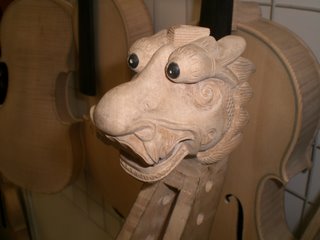
Artwork abounds among Chinese violin makers, as this elegantly hand-carved dragon head cello scroll demonstrates. This piece was designed by an American distributor and produced by Taixing Xinyi Strings Company from Jiangsu Province.
Sax Muffler
Tired of neighbors banging on your door when you're trying to practice at 2 am? For just 2,200RMB (275USD) wholesale, you can muffle your sax without having to use those old socks you haven't washed for a few weeks. The Sax Partner cocoons your horn in a sound proof case while you practice those sometimes shrill harmonic overtones. A battery operated sound converter pumps the sound back into earplugs that you wear as you play. If you can read Chinese, log onto http://www.vibesmusic.com.cn If you're Chinese illiterate, contact me.
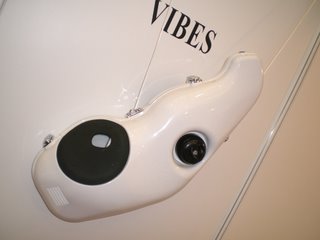
Blowing Their Horns at Taishan
As mainland-made saxophones continue to improve in quality, Shandong Taishan Wind Instruments remains one of the leading makers of student-level to intermediate horns. This Sino-American joint venture boasts 30 percent overseas sales and dominates the local Chinese market.
Perhaps their tour-de-force is their soprano saxophones of which there are currently about 20 different models with a variety of finishes including gold, silver and nickel lacquered and plated as well as dotted antique brass and dotted antique copper plated and black nickel plated.
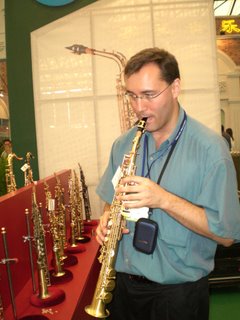
The action on the sop saxes is smooth and the key fittings are comfortable. Sales reps at the Shanghai show told me that the pads are also made in China. The tone quality of most of the sops tends towards the bright side.
Export prices for Taishan's sop saxes range from 160USD to 245USD. For more information, log onto www.taishan-guanyue.com
When Metal Meets Plastic
Plastic or metal? That's what Geoffrey Guo, from Taiwan, had listeners guessing as he played his own patented Grenaditte flute, which is a composite of 12 different materials including plastic. The name “Grenaditte” comes from grenadilla, the dense, dark wood typically used to make clarinets and oboes.
Despite its dark, matte coated appearance, Guo's flute boasts a few advantages over traditional metal flutes. “The best thing about this flute is that you don't have to warm it up,” said Guo, who added that the flute was tested in 14 degrees Fahrenheit where it played as normally as in warmer temperatures.
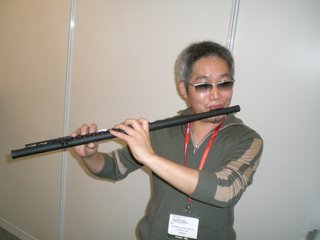
The flute plays easily in the higher registers and has a good jazz sound. “The harmonic interval is very stable,” said Guo, who added the flute's light weight also makes it easier for younger as well as older musicians to play, who may struggle with keeping the flute at a balanced level perpendicular to the floor.
Guo's Grenaditte flute is fitted with Pisoni DFL-407 pads from Italy and retails for about 2,500USD. Find out more about Guo's composite flutes at www.flute.com.tw
Handmade Pianos
While some piano makers such as Pearl River dominate the domestic market for low to medium-range keyboards, there are a growing number of local factories producing high-end pianos. Nanjing Changjiang Piano is one of them.
Since 2000, the company has been producing hand-made grand pianos such as the one pictured below which is made mostly of imported rosewood. The company is now looking for overseas distributors to market their pianos abroad.
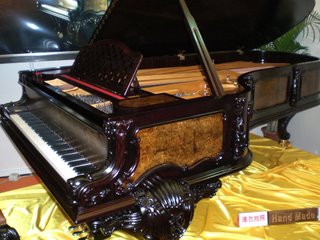
According to Chen Wei, a sales manager for Nanjing Changjiang Piano, a variety of rare wood including rosewood, walnut and Alaskan spruce, are in demand for the production of their pianos.
“The wood we order is very rare,” said Chen. “First it takes about 40 to 50 years for the trees to grow to a size where they can be used, then it takes another 10 to 15 years for the wood to mature to a point where it can be crafted.” Write to Nanjing Changjiang Piano at bellmountainpiano@hotmail.com
Putting Their Metal Where Their Mouth Is
Move over Meyer, as foreign and domestic mouthpiece manufacturers move into the mainland. When it comes to metal and hard rubber mouthpieces, a handful of makers are taking a stab at penetrating the growing woodwind market in China.
Native New Yorker Jody Espina is one of those innovators who are aiming for the high end mouthpiece market with his metal and hard rubber Jody Jazz series.
With an aim to create a mouthpiece for every player, Espina has established a spectrum of clarinet and saxophone mouthpieces from beginner to professional levels. Since 2000, Espina, a professional player and teacher, has been perfecting his mouthpieces after working under the tutelage of French mouthpiece master Santy Runyon. Espina says he tests all mouthpieces himself before they go out to market. All pieces are either produced or finished in the United States.
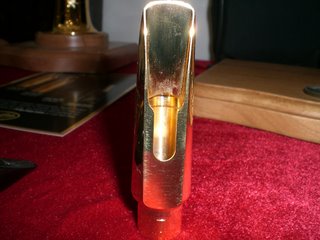
Among his arsenal of works is the Jody Jazz DV which contains a “secondary window” opening below the face of the mouthpiece (See above photo). The additional opening exposes more of the bore chamber and allows for greater reed vibration thus creating a fuller, warmer tone and facilitating easier access to harmonic overtones. It's altissimo made easy.
Alto Sax mouthpiece tip openings range from 5 to 8 and tenor openings go from 5 to 9. Mouthpieces for soprano and bari saxes are also available. For more info, log onto www.JodyJazz.com or write to jody@jodyjazz.com
On the low end of metal mouthpieces, Tianjin Hanbang Musical Instruments is working its way into the local and foreign market. Their alto sax mouthpieces play with brighter tones compared to other makers and are mostly nickel or silver plated. Unit prices range from 17.50USD for alto sax mouthpieces to 37.5USD for bari sax mouthpieces. (See photo below)

Reed All About It
While reed cane grows naturally in China, reed makers have a long way to go before coming close to the industry benchmark which has long been held by Vandoren Inc. However, that hasn't stopped home grown manufacturers from trying to crack the market.
At this year's Shanghai show, there were about a half dozen local and foreign reed makers displaying their products. Among Chinese brands were Ri Yin and Flying Goose, both from Shanghai. Some foreign manufacturers included Music Center Spa of Italy and reeds australia, based in Southern Australia.
I decided to take some 2.5 alto sax reeds from Ri Yin, Flying Goose and reeds australia myself and do some comparison. It took a few minutes to warm up to each of the reeds but generally the China-made reeds played brighter and were thinner than the Australian reeds, which had a more woody texture and warmer sound and were stiffer.
The domestic reeds were better than expected. I played a Ri Yin 2.5 reed that was coated in some black material (See below photo). When I asked one of the sales people what was in the coating, I did not get a straight answer but was told “it's not poisonous”. Well, he was right. I didn't die after playing it, nor were there any adverse side affects and my tongue did not turn a strange grey-black hue.

In China, most reeds are grown in Anhui Province, where there is an ample supply of water and favorable agricultural conditions. Since the use of pesticides is an issue, it is sometimes hard to tell what chemicals China-grown reeds are exposed to.
Peter Handsworth, Managing Director of reeds australia, however, assures that his Australian-made product is organically grown and with irrigation to regulate the amount of water intake (See below photo). According to Handsworth, it takes about two years before the reeds can be harvested and between three and six years before they can age properly before they are processed.
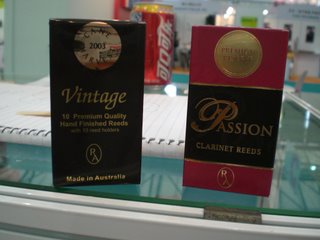
For more info on Flying Goose reeds log onto www.shaopian.cn For info on reeds australia see www.reedsaus.com.au
Getting It Straight
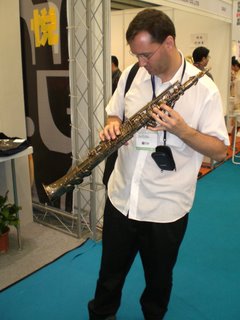
Finally, one of the show's more peculiar pieces was this straight alto saxophone by Beijing Feifan Tianyue Industry and Trade Co., Ltd. Shoddy foot welding and key work were enough to discourage me from playing it. Sales personnel said that the brass body is made in cooperation with a German company and that the pads were from Italy. For more info log onto www.china-sax.cc


